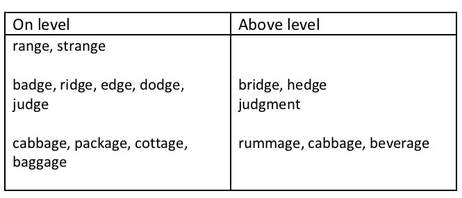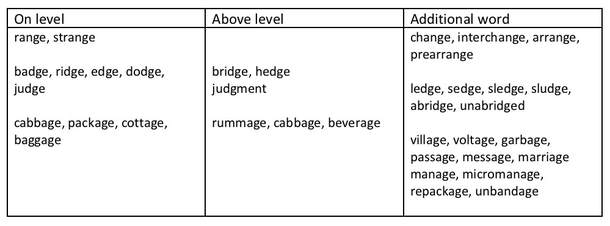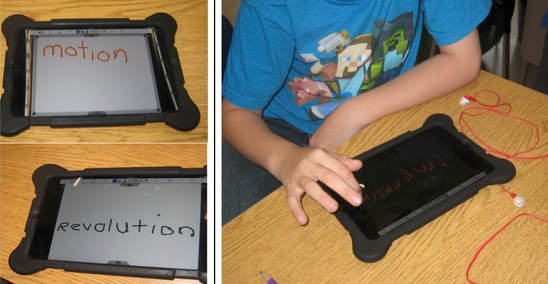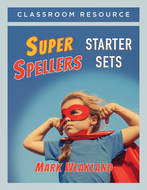|
I recently returned from the CREST Conference, where I presented on spelling (and its ties to reading) to Texas curriculum and instruction directors. Audience members had great comments and questions. Two questions really resonated with me and I’ve decided to write about one in this blog. I’ll discuss the second, which has to word study and workshop-model teaching, in my October posting, so stay tuned! At CREST, the most common comment and subsequent question was “We know about sound-letter activities for younger kids, such as stretch-tap-spell, Elkonin boxes, and simple word ladders, and our teachers do them in their classrooms. But what do you suggest for older spellers, especially 4th through 6th?” First, I would suggest that even older students may need a brush up on hearing the syllables in the words. Use the jaw drop for this (tip of the fingers go under the tip of the chin, feeling the jaw as it unerringly moves up and down for the vowel in each syllable). And for any older students who struggle with phonology, teachers may want to have these students stretch some syllables and then tap out their sounds. I would also suggest that patterns are still a foundational place to operate from when it comes to teaching fourth, fifth, and sixth graders. But in these grades, pattern thinking is more sophisticated. First, patterns can be tied to the seven syllable types and the rules that govern their spellings and exceptions. Researchers and writers say there are six, but I like to think of them as seven:
Finally, when it comes to older spellers, I think another foundational place of operation is the idea of a deep and rich word list for each lesson. A deep and rich word list -one with a large number of varied words tied together by just a few patterns- accomplishes a number of things:
For example, here are some of the words from a Unit 17 in Zaner-Bloser’s Spelling Connections. If you use this program, you are already at an advantage because every master list in a Spelling Connections lesson is lengthy and differentiated. In other words, it is already relatively deep and rich. I’ll start with some words (not all) from one of their fourth-grade lists that focuses on “soft G” spellings. I’ve grouped the words so that the patterns are more apparent. Next, I’ll add a few more words. Adding words provides you with opportunities to easily expand the spelling lesson into reading and vocabulary (more on this in October). The added words also provide words for differentiated take-home spelling lists. Now, what activities can we do with this deep and rich word list? Certainly, word sorts. But word dictation is another effective and easy activity to do. Kids can write with paper and pencils, white boards and markers, or an iPads and stylus. I use the routine of “I say, we say, you say, you write.” Thus, village would sound like this: “The word is village. I live in a village. Say it with me. You say it. You write it.” After the kids have checked their spelling against mine (on the board), I would directly and explicitly give the word meaning. “A village is a small group of houses and buildings. It's smaller than a town. Villages are in the country.” I also like to dictate related words that aren't on take home spelling lists. My little chant is “If you can spell ____, you can spell _____.” Thus, I might do this for the word pillage. “The word is pillage. The Vikings began to pillage the village. Say it with me. You say it. You write it. And don't forget, if you can spell village, you can spell pillage” Once again, after the kids have checked their spelling against mine, I directly and explicitly give the word meaning. “Pillage means to attack a place and take things away. Pillage is like looting or aggressively stealing.” In a seven-minute word dictation session, you can go through 10 or more words if you keep your instruction brisk and explicit and don’t let the kids interrupt the routine with chatter and superfluous talk. At the very end, read the entire list of words written on the board. Do “I Say, We Say, You Say” and you will add repetition for English Language Learners and children who have a reading impairment. You will also effortlessly tie your spelling to phonics (encoding to decoding). Viola! Word ladders are another quick and efficient activity to do. You don’t have to write them out in worksheet form and with older spellers, you don’t have to think “one letter, diagraph, or vowel team at a time.” You can create new words by swapping in entire syllables at the prefix, suffix, root, or root word level. Just be careful that your jumps between words isn’t too dramatic. As you go through a word ladder with a large (or small group), tie in vocabulary by telling the students what the new target word means. Also, discuss rules (when to drop or not drop silent E, how to form the past tense, etc.) when the opportunity presents itself. Here are two word ladders that are based on the fourth-grade words presented above. Cabbage-baggage-rummage-cottage-village-marriage-package-unpackage-repackage Bridge-abridge-abridged-ridge-range-strange-change-interchange-changeable-unchanging
Sentence dictation and flip folders are two other 7 to 10-minute activities that work with 4th, 5th, and 6th graders. I’ll mention older spellers again in my October blog when I discuss the second big comment and question from my CREST audience: “How can my teachers teach spelling, then phonics, then vocabulary in when they have so little time to teach, and how does this all work with a workshop-based school district?” My suggestion? Think in terms of Word Workshop! What’s Word Workshop? I’m still figuring it out but I should have a decent answer by October! Comments are closed.
|
Mark WeaklandI am a teacher, literacy consultant, author, musician, nature lover, and life long learner.
|




 RSS Feed
RSS Feed